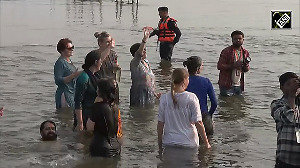Rediff.com caught up with Air Marshal K C Kariappa (retd) to find out what could have happened.
The air marshal said the terrain, where the helicopter's wreckage was found, appeared to be an extremely difficult one. Bad weather added to the search and rescue teams's problems on Wednesday.
He felt there could be two reasons why the helicopter's pilots did not send distress signals. Either, an explosion had taken place mid-air or following its forced landing, giving the pilots absolutely no time to send out a distress signal.
"Choppers usually have equipment that emit distress signals in case of a forced landing or a crash," Air Marshal Kariappa said.
Once a pilot enters a cumino nimbus cloud, the aircraft gets sucked in and is forced downwards. There is very little that a pilot can do in such a situation. The aircraft starts to pull downwards towards the ground in such a situation and there is no control on where the aircraft will land.








 © 2025
© 2025